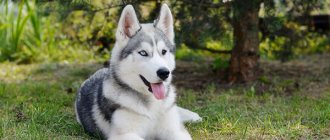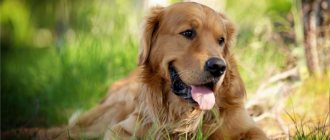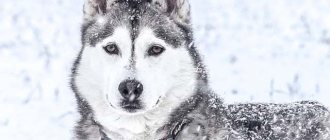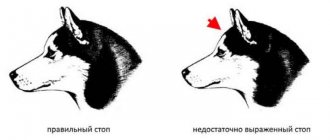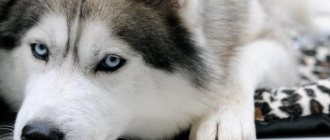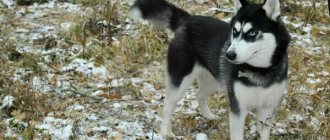Training a husky seems difficult to many people, or even completely pointless - this is due to the talk that dogs of this breed are almost impossible to raise and teach commands. In fact, on the streets of different cities you can increasingly meet well-mannered huskies who calmly move next to their owners and follow the command “Next!” even without pulling on the leash. It turns out that this breed can still be trained! Today we will tell you how to productively and successfully help a husky learn the basics of obedience, talk about home training a puppy, group classes with a dog handler, as well as methods of positive reinforcement and punishment for a dog.
Husky training: general training course
Facts about Husky character and temperament
Huskies as a breed were formed in very specific conditions - they were bred in the northern territories, caring only that these hardy, intelligent and fast dogs would help people, effectively replacing transport in difficult conditions. Accordingly, Husky dogs had to perform two functions: work in a team and tirelessly pull sleds with loads or people. Therefore, no one demanded obedience from dogs (in the modern classical sense), as well as the qualities of a companion or guard.
Sled dogs are highly independent
In addition, huskies have always been those dogs that are capable of making decisions on their own. Since the fate of the person and the cargo depended on the dogs, and especially the leader of the team, the dogs independently chose a safer path, avoiding predators and dangerous places, and also sensed the approach of bad weather. Accordingly, independence is a quality that is fully inherent in huskies, and modern dogs are endowed with it no less than their working ancestors.
The second quality characteristic of huskies is imitation. Initially, these are dogs that live in packs, travel in harness, and younger dogs always looked at older and more experienced ones, adopting their behavior. In addition, huskies are weakly attached to a specific person, because the handler of the sled could be constantly changed, and the dogs were often sold from musher to musher. Therefore, Husky dogs are much closer to their brothers than to humans.
For a husky, the company of its own kind is extremely important.
Husky character traits:
- Tendency to dominate.
- Rebellion, independence.
- High level of intelligence.
- Stubbornness, willfulness.
- Tendency to run away and wander.
- Highly developed hunter instinct.
It is precisely because of the combination of such complex psychological characteristics that huskies are not recommended for beginners, as well as for people who are not ready to devote a lot of time to long walks with the dog, training and obedience training.
Husky: primitive beauty
Yes, many people are captivated by the appearance of the husky, from which it is impossible to take their eyes off. But, you need to understand that behind this wild and primitive beauty lies a complex character. In order to comfortably coexist with a Husky dog, you need to comply with at least one of the two most important points:
- Get a dog (or several at once) for sledding sports, competitions or work.
- Get a dog and be prepared to devote at least three to four hours to it every day.
Huskies need to be raised from a very early age.
History of the origin of dog sleds
Huskies received their role as a riding pet about 2 thousand years ago. Initially, riding these dogs was not a unique form of recreation. In Russia, not a single northern expedition could do without such reliable helpers and companions as the Huskies.
Reference. The maximum skill in driving sled dogs has been achieved by the population of the Siberian territories, the Far East and the North.
For a long time, northern sled dogs were considered the best option for traveling across the endless snow-covered plains of the North. It was during that period of time that various dog sledding competitions arose (at one time there were plans to introduce the corresponding type of sport into the Olympics, however, that was all over).
Despite their excellent physiological characteristics, as well as natural endurance, Huskies are not capable of being excellent service pets. They do not have a developed sense of ownership, in other words, territoriality, for this reason these animals are not the best option as guards and defenders. But for the Husky show they are just perfect.
Some dog breeders try to instill in their pets such qualities from childhood, which is fraught with the appearance of various mental problems in the animal. The majority of Huskies are distinguished by their obstinate and freedom-loving character, for this reason they require a special approach during the training process. These pets are surprisingly good-natured and do not pay any attention to the kids’ antics.
While riding, a bunch of dogs energize all the people around them with their love of life and energy. They are characterized by the presence of a pack instinct. Therefore, you should purchase several large pets. True, everything here depends on the financial capabilities of the potential owner.
Features of husky training
A Husky owner who intends to teach his dog basic commands and general obedience must understand why this is necessary. First of all, you need to train a husky in order to be able to live comfortably with your pet: go for a walk, leave the dog at home alone, and establish interaction between the dog and the rest of the family.
An ill-mannered dog will pull on the leash with all his might, going about his own business, regardless of whether it coincides with the route the owner wants to take or not. Once released from the leash, the dog is most likely to disappear in an unknown direction.
Without training, a husky will destroy the apartment, gnaw the owner's things, howl and bark alone. In addition, wayward dogs tend to dominate people and other animals, so an untrained husky can get into a fight with another dog, will certainly chase cats, and may also growl or even bite one of the family members, especially a child.
Without proper upbringing, a Husky can cause a lot of problems.
Accordingly, the husky must learn the most important basic commands, which are otherwise called household commands. These include: “Next” (walking at the handler’s left knee on a loose leash), the “Stand - sit - lie” complex, the “Place!” , "To me!" (return from a walk), prohibiting command “Ugh!” or “You can’t!” (for example, a ban on picking food from the ground). You can also learn other commands from the husky, for example “Fetch!” - presenting an object thrown by the owner, as well as hone basic skills by teaching the dog to carry out commands not only by voice request, but also by gesture.
A dog that knows basic commands can be trained further, for example, agility
When starting to train a husky, you need to know some features of this process and even tricks that will help make training more effective:
- Before taxing your dog mentally, you need to give it the opportunity to burn off its energy and physically tire the dog out (in the case of a husky, at least try). Accordingly, before classes you need to arrange a long-distance husky race - on skis or a bicycle, let the dog have a good time frolicking, and only then train it.
- Attend group classes with a dog handler. Since huskies are prone to imitating, they will learn the necessary commands much faster if there are other dogs around doing the same thing. It’s not bad if the group has an already trained dog that the husky can look up to, as an example - often this is a dog that belongs to the instructor.
- Do not try to influence the dog with violence. Huskies are fearless dogs with a low pain threshold, so the owner’s screams, much less physical punishment, will not impress the dog, but will only make it more withdrawn. Husky training (and any other breed) should be based on positive reinforcement (affection, treats), as well as repetition and steadfastness of the owner.
The dog should enjoy the training process
Video – Husky training
How to put on a harness and make a dog sled
Each sled dog must have its own individual harness, depending on the size and weight of the animal.
The algorithm for putting on a harness looks like this:
- To put the harness on your dog, you need to “straddle” it, holding the dog’s waist with your knees. This way, even a very temperamental dog will be under your control, and you will have your hands free to deal with the harness.
- With your left hand, take the harness by the crosshairs of the neck straps, and with your right hand, by the rope loop of the harness, to which the traction line carabiner will be attached.
- Determine the lower chest part of the harness, which should be located between the dog's front legs.
- Place the harness on the dog's head so that the chest strap is located between the dog's legs and the rope leash attached to the back straps is in the center of the back towards the dog's tail.
- Place your front paws through the harness and straighten the straps across your back and sides.
- After this, check again how the harness fits.
Depending on the size of the sled, the load and weather conditions, the team can have from 4 to 8 or 12 dogs. The dog's traction leash is attached to the central pull. The dogs are placed in pairs, at a distance of approximately 2 m from the next pair.
The length of the central pull and the entire team together with the sledges can be 15 meters if, for example, 10 dogs are harnessed to the team. The central pull is attached to the sled with a special carabiner.
When should you start training a Husky?
Raising a dog should begin in the very first days after it gets to its new owner. However, the concepts of “education” and “training” should not be confused. Up to three or four months, the puppy only needs to be taught good manners, taught the rules of behavior, as well as how to interact with people and other animals. So, at the age of one and a half to two months, the puppy is already able to learn the following points:
- Learn to perceive your nickname and respond to it.
- Know all household members and distinguish them from strangers.
- Understand that a person provides food, shelter and protection, and therefore is a leader.
- Learn a prohibition command (“No!”, “You can’t!” or “Ugh!”), which stops unwanted actions.
You need to train your dog from a very early age.
Then the puppy is taught such things as an adequate attitude towards a collar, leash and muzzle, and is introduced to the street, while at the same time helping the puppy to master the toilet during walks. The puppy will quickly learn the listed skills if the owner shows a patient and gentle attitude.
There is no need to scold the puppy if he is afraid of transport or crowds of people, and you should also not be angry with the baby who could not wait to go for a walk and relieved himself indoors. You need to respond to a small dog's mistakes gently, encouraging correct behavior and ignoring fears.
Socialization is extremely important for a husky puppy.
At the age of three to four months, the puppy needs to be actively socialized - show him as many new things as possible, take him on various trips, build new routes for walks. Huskies have a flexible psyche and animals adapt well to all situations if they actively learn about the world around them from childhood. You also need to introduce your little husky to other dogs.
To do this, you need to choose good-natured and non-aggressive dogs with whom the puppy will start playing. This way, the dog will understand that its relatives can be excellent entertainment partners, and will not try to dominate or show aggression in adulthood.
Playing with other dogs will allow your husky to burn off a lot of energy.
What is Husky sled riding like?
Today, Husky sled riding is a fairly active form of recreation, which is incredibly popular not only among adults, but even among the smallest children. Currently, there is absolutely no need to go to the northern regions of the country for this.
Since these animals are distinguished by incredible endurance and significant adaptability to harsh climate conditions, this process for animals is not a necessity, but a great pleasure.
Currently, throughout Russia there are a large number of all kinds of specialized centers that provide the opportunity for absolutely everyone who wants to take a dog sled ride. Center employees provide master class services on mastering the skills of independent team management, with the opportunity to try on the role of a driver.
Transition to basic training
When the husky puppy is three to four months old, the best decision would be to sign up with him for group classes in UGS (“Manageable City Dog”) or OKD (general training course). Such classes are conducted by a canine instructor; the group usually trains about ten dogs of the same training level. Of course, the puppy will study first in the most inexperienced group, gradually increasing the levels of training.
Important point! There is no need to try to teach a husky puppy commands on your own if this is your first time with a dog of this breed. Mistakes made will take much longer to correct, and it is easier to immediately practice under the supervision of an experienced zoo specialist than to then correct the dog’s behavior.
What is included in the OKD of dogs?
It’s good if the instructor you choose has experience working with huskies and knows the peculiarities of their temperament and psychology. But, in general, training a Husky is no different from training any other breed. Perhaps the owner will have to put in a little more work, show patience and tact towards his pet, and also work tirelessly to repeat and “polish” the learned commands.
With due diligence, the owner of the husky will be able to successfully complete a basic obedience course! The main thing is to properly motivate the dog, reward successes in a timely manner, and also work out the moments that don’t work out. Let's take a closer look at how to praise and punish a dog during the training process.
Video - Husky passes the OKD exam
Methods of rewarding and punishing huskies
Any training should be based on the carrot and stick method, that is, timely punishment of the dog for unfulfilled (or incorrectly executed) commands, as well as rewarding the pet for obedience and intelligence. Note that the most effective is the positive motivation of the animal - it is the method of positive reinforcement (PP) that should be used in training a husky.
So, group lessons with a dog trainer imply that the dog will be wearing a soft collar (in no case a strict one, with spikes - this is prohibited), as well as a leash of sufficient length. In addition, the owner must bring a sufficient amount of treats with him.
Rewarding your dog with treats is the most effective way
The most desired product for a husky can be used as a treat: meat, cheese, dry food or other tasty treat. The main thing is that the pieces of food are small, so that the dog only has time to feel the pleasant taste, and does not get full by the middle of the lesson. For every correctly performed action, the pet receives a tasty reward.
Example: the dog is taught the command “Sit!” . For the first time, the puppy needs to be shown a treat clenched in his fist. The hand with the food is raised near the puppy’s nose, at the same time they pronounce the command and, if necessary, lightly press the dog on the croup. As soon as the puppy sits down, you need to praise him vigorously and at the same second give him a treat.
The owner hides a treat in his hand to reward the puppy for its success
It is in this vein that each training will take place. The command is learned or repeated with the dog, and for each (every!) correct execution the pet must be praised, rewarded with treats and affection. But what to do if the dog is stubborn or does not want to comply with the owner’s demands?
The punishment for unwanted actions is extremely nominal. Firstly, a dog that does not follow a command, or thinks about it for too long, is not rewarded with a treat. Secondly, the dog is forced to perform the desired action mechanically. If we are talking about the command “Sit1”, the dog is seated with your hands; if we are talking about the command “Near!” - then if the dog deviates from the trajectory, the dog is corrected using a leash, making a jerk.
Positive motivation makes the dog interested in the learning process
Who can ride dog sleds?
Children over 10 years of age and adults with good balance can ride independently on dog sleds. If you are well physically prepared, ski or ski, then controlling dogs will not present much difficulty for you, because driving a sled also requires the ability to maintain balance.
It is safe for people of any age to ride as passengers; small children can board the sled only with their parents. You can ride as a passenger only with an instructor.
Interesting on the site: Dog breeds similar to huskies

